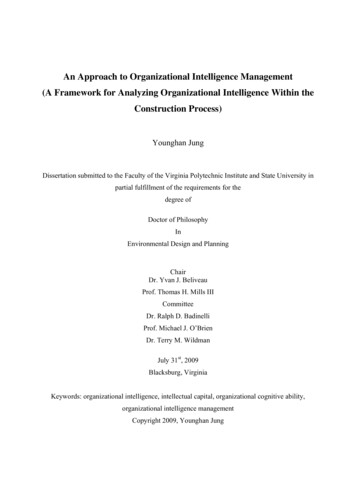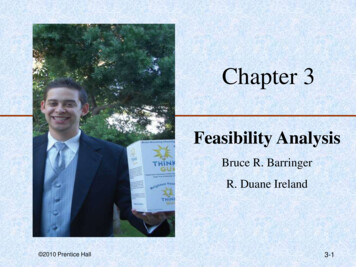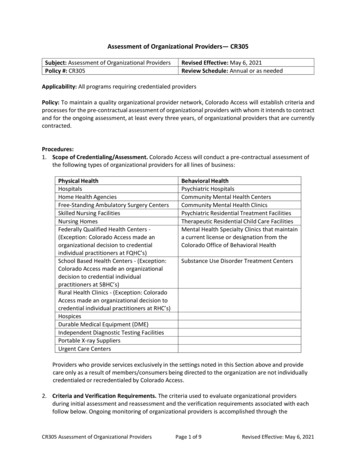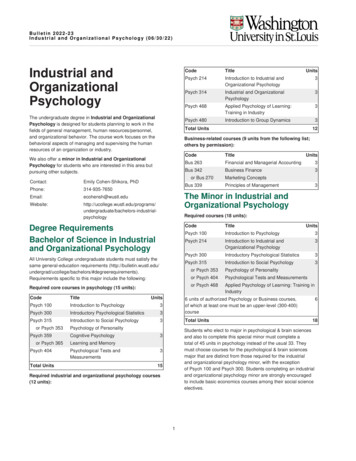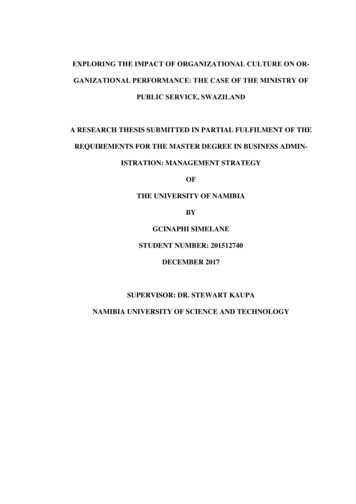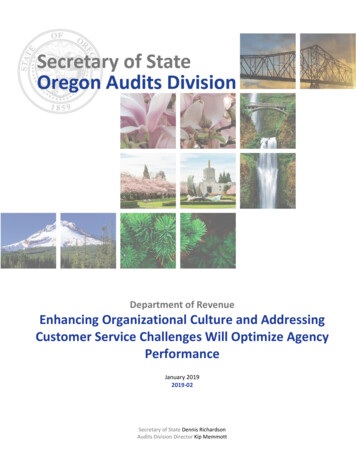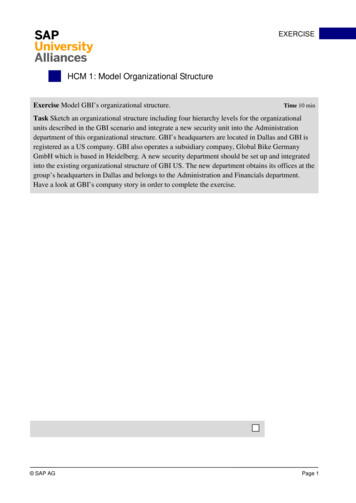
Transcription
DATA MODELS AS ORGANIZATIONAL DESIGN: COORDINATINGBEYOND BOUNDARIES USING ARTIFICIAL INTELLIGENCETom SteinbergerUniversity of California, Irvine andSolbridge International School of Businesststeinbe@uci.eduMargarethe WiersemaUniversity of California, Irvinemfwierse@uci.edu
DATA MODELS AS ORGANIZATIONAL DESIGN: COORDINATINGBEYOND BOUNDARIES USING ARTIFICIAL INTELLIGENCEAbstractOrganizational design scholars observe that advances in information technology are helping blur theboundaries between a firm’s internal and external activities. Yet despite the central role of informationprocessing in managing the coordination of activities within the firm, we know little about the firm’sability to process information beyond its boundaries. We provide a framework for understanding thecoordination of activities beyond the firm’s boundaries in terms of micro-structural solutions toinformation provision. Our core insight is that organizational design can be modeled at the level ofdata. The firm’s ‘data model’ shapes processes of data integration using artificial intelligence,enabling agents to frame and find their problem contexts and self-organize activities. We contributeto the organizational design and strategy literatures by showing how coordination beyond boundarieshas major, yet neglected, micro-structural effects on how firms organize. We discuss researchimplications for managerial capabilities, corporate strategy amid digitalization, and models ofstrategic representations.1
DATA MODELS AS ORGANIZATIONAL DESIGN: COORDINATINGBEYOND BOUNDARIES USING ARTIFICIAL INTELLIGENCEINTRODUCTIONThe scope choices underlying a firm’s activities have traditionally concerned make-or-buydecisions within an industry value chain. Boundaries are clearly demarcated. The firm coordinatesactivities performed in-house by internal employees and divisions, while those performed by firmsor agents1 externally are handled through arms-length contracts such as supplier relationships,alliances, or partnerships. Organizational design scholars, among others, have observed thatadvances in information technology have helped blur the boundaries between internal and externalactivities (Benner and Tushman, 2015; Joseph, Baumann, Burton and Srikanth, 2018). Improvedinformation processing capacity (e.g., 4g networks, cloud services, faster processors, smartphones)has enhanced coordination capabilities, reduced transaction costs, and made possible novel valuepropositions and business models (Helfat and Raubitschek, 2018; Teece, 2017; Fjeldstad and Snow,2018). Scope choices increasingly concern a firm’s ability to harness this improved informationprocessing capacity to shape how agents self-organize their activities (Gulati, Puranam andTushman, 2012; Fjeldstad, Snow, Miles and Lettl, 2012).In comparison to the conventional industry value chain, firms able to harness improvedinformation processing capacity to coordinate activities beyond boundaries can realize benefits ofeconomies of scale and scope, leverage complementarities in resources, and develop more flexiblecapabilities for innovation and search (Thomas, Autio and Gann, 2014; Jacobides, Cennamo andGawer, 2018). Yet while information processing capacity has been essential to the internalcoordination of the firm (e.g., Tushman and Nadler, 1978), extant perspectives on coordinatingbeyond the firm’s boundaries have tended to subordinate analysis of information processing.Instead the focus has been on relatively macro-level components of platforms or rules ofcollaboration in ecosystems, marketplaces or communities (e.g., Gawer, 2014; Afuah and Tucci,2012). As a result, while we have rich insights into relatively macro-level components and rules,micro-structural mechanisms (Puranam, 2018) by which firms develop the capacity to processinformation beyond their boundaries remain little explicated.1We adopt the broad sense of the term agent suggested by Puranam (2018: 6) as ‘any entity capable of action’.2
The importance of how firms develop information processing capacity beyond theirboundaries is highlighted by the emergence of digital data as a central strategic resource. Vastlyexpanded ability to acquire and analyze a variety2 of digital data has made integrating this data toprovide information among the most complex and visible issues that firms face. The very existenceof digital platforms (e.g., Google, Facebook, DropBox) is premised on scalable capabilities forharnessing diverse data to provide context-specific information to users. Ride sharing services suchas Uber or Lyft depend on users’ ability to interact with an evolving database of information aboutlocal drivers and passengers. Across typical enterprises, a virtually universal strategic goal hasbecome the integration of silos of data into centralized data warehouses for more effective use ofinformation in their activities. GE, for instance, estimates it saved 80 million per year in localmanagers’ everyday negotiations with suppliers simply by integrating procurement systems acrossits divisions and subsidiaries (Davenport and Ronanki, 2018).Harnessing digital data effectively can thus enhance the activities that the firm coordinatesby augmenting agents’ capacity to process information. The fact that this data is generated frommultiple sources for use in diverse problem contexts3, however, has led to data integration beingviewed as the ‘800 pound gorilla in the corner’ (Stonebraker, 2015: 2). To effectively integratenumerous silos of data, the firm must not only acquire and classify the data, but also determine howto make it available so that agents are provided with the requisite information they need in theiractivities. Given that the firm cannot sufficiently anticipate the problem contexts of its agents’activities, it needs to integrate data in such a way as to flexibly provide information for agents toframe and find problems on their own (Nickerson, Wuebker and Zenger, 2017). Explicatingmechanisms by which firms integrate data effectively and flexibly is therefore important tounderstanding how firms coordinate activities beyond their boundaries.Artificial intelligence (AI) has emerged as a key tool for enabling data integration beyondboundaries. Firms use AI (i.e., deep learning algorithms, logic programs, sensor networks) to filter,classify and make predictions from their data. To the extent that a firm is able to use AI to processdata regarding agents’ activities, the firm can determine which data can be used to provide2We emphasize the increase in the variety of data that firms collect and analyze, rather than increases in the amount (volume) orspeed (velocity) of data (Stonebraker and Ilyas, 2018). Data volume and velocity pose primarily technical challenges; data varietyposes both technical and organizational challenges that arise even at low volume and velocity.3 By problem context, we refer to ‘challenges, opportunities, situations [and] alternative possible future states’ (Nickerson andArgyres, 2018: 592) underlying activities. Nickerson and Argyres (2018) use this definition to characterize strategy formulation. Weargue that analogous processes characterize agents who self-organize their activities.3
information specific to agents’ problem contexts. Determining which information to provide toagents is known within the organizational design literature as the problem of information provision.Solutions to information provision — or how agents get enough information to execute theiractivities and coordinate with others (Puranam, Alexy, and Reitzig, 2014) — are viewed asuniversal elements of a firm’s organizational design for integrating the efforts of agents (Schelling,1960; Lawrence and Lorsch, 1967; Puranam, 2018). Like firms’ use of other informationtechnologies (IT), then, how firms integrate data using AI has implications for organizational designstrategy.In this paper, we develop a framework to understand how firms integrate data using AI as asolution to information provision beyond boundaries. First, we describe how organizational designbased on the division of labor constrains the ability of the firm to coordinate activities beyond itsboundaries. Then, we lay out our framework by developing the idea of a firm’s data model asorganizational design based on information provision. By data model, we refer generally to any‘collection of high-level data description constructs’ that can be easily accessed and manipulated byusers (Ramakrishnan and Gehrke, 2000: 9). After laying out our framework, we give someempirical context through two short cases analyzing the role of data integration in coordinatingactivities beyond firm boundaries at Novartis and Airbnb. We then identify a firm’s strategicdecisions for developing its data model, which involve identifying archetypal problems ofinformation provision, representing agents’ problem contexts, and assigning credit for dataintegration efforts.Our core insight is that organizational design can be modeled at the level of data. Decisionsregarding the firm’s data and how it integrates its data could be viewed as more technical thanstrategic in nature, and thus more in the domain of database management or software engineering.We believe that such view would be critically shortsighted. Consider the core process in strategyformulation of theorizing which activities the firm should engage in to create value (Felin andZenger, 2017). For the firm to provide information beyond boundaries, it needs to in some wayrepresent its activities within some sort of a database. Keeping the firm’s database logicallyconsistent yet adaptable to self-organizing agents’ diverse, evolving problem contexts depends onunderstanding its theory of value creation, the information that agents need about activities, howthese agents wish to access and manipulate this information, and the broad technical implicationsfor the firm’s database design. The firm’s data decisions are therefore strategic, in that they clearly4
call for a ‘capacity to imagine and model complex interactions with both internal and externalactors’ (Leiblein, Reuer and Zenger, 2017: 559).We draw on our core insight that a firm’s organizational design can be modeled at the levelof data to contribute to the strategy and organizational design literatures. Our framework showshow the coordination of activities beyond the firm’s boundaries has major, yet neglected, microstructural effects on how the firm organizes that relate to its solutions to information provision.Extant research on firm boundaries does not fully account for these effects due to its tendency tofocus on problems of division of labor. We discuss how the need to integrate data to coordinatebeyond boundaries reveals the need for distinct managerial capabilities for data abstraction, andwhich call for a more micro-structural understanding of a firm’s architectural knowledge. Wefurther discuss implications for literature on corporate strategy amid digitalization, showing how afirm’s data model can offer important insight into the nature of a firm’s activities beyondboundaries that are not captured by the more macro-structural approaches that are currentlypredominant. Finally, we lay out future directions for how a firm’s data model can be used as abasic organizational design variable in the nascent literature on firms’ strategic representations.INFORMATION PROVISION BEYOND BOUNDARIESAccording to Puranam et al. (2014:165), the design of a functioning organization must solve ‘twofundamental and interlinked problems: the division of labor and the integration of effort’. Thedivision of labor consists of task division and task allocation, while the integration of effort consistsof rewards provision and information provision.Much research finds that a firm can coordinate effectively with an organizational designthat is based on solutions to division of labor. Examples include the use of modular task structuresfor innovation, and the adoption of organizational hierarchies, networks or polyarchies according tothe firm’s technological and competitive environments. Using solutions to division of labor to guidesolutions to information provision (e.g., as in conventional enterprise resource planning (ERP)software), however, can impose too much structure for information to be adaptable agents’ diverse,evolving problem contexts (Kallinikos, 2004). Effective, flexible solutions to information provisioninstead tend to be characterized by being largely ‘pure’4 — or independent from — structuringWe adopt the term ‘pure’ from the computing and artificial intelligence literatures, where the analogous term for informationprovision-related processes is ‘messaging’. ‘Pure’ messaging to refer to the ability of an agent (human or artificial) to provideinformation without pre-determined communication channels (Hewitt, 2014).45
based on how the firm divides and allocate tasks. As a simple example to contrast with ERP, afirm’s email system can be viewed as ‘pure’ information provision in that an agent can send orreceive messages to any agent for whom they have the email address, regardless of the tasks or rolesinvolved. We describe the basic distinction we make between organizational design based onsolutions to division of labor versus information provision in Table 1 SERT TABLE 1 ure’ solutions to information provision are broadly consistent with Carnegie Schoolinspired theories in organizational design in which coordination is based on shaping agents’adaptive search processes, rather than specifying task division or allocation directly (e.g., Levinthaland Warglien, 1999). While organizational design research using these theories has largely taken abehavioral approach, recent work on strategy process from the same tradition identifies managers’representations as mechanisms for modeling their search environments (Csaszar and Levinthal,2016; Puranam and Swamy, 2016; Csaszar, 2018). By creating, modifying and manipulatingrepresentations, managers can augment their use of judgment, theorizing, and analogizing to shapethe very nature of the firm’s activities (Leonardi and Bailey, 2008; Foss and Klein, 2012; Helfat andPeteraf, 2015; Nickerson et al., 2017; Gavetti, Helfat and Marengo, 2017). We argue that solutionsto information provision beyond boundaries likewise can be viewed in terms of how the firms’agents as a whole use representations. To the extent that the firm can augment such use ofrepresentations across all of its agents, it can enhance these agents’ ability to frame and find theirproblem contexts and self-organize activities.Next, we develop our framework for understanding solutions to information provisionBeyond firm boundaries. We first introduce firms’ use of AI as a key tool in developing suchsolutions amid firms’ vastly expanded ability to access and analyze digital data. After defining AIas used by firms, we show how it plays a role in information provision beyond boundaries byhelping the firm integrate pervasively semi-structured data regarding agents’ activities. We thendevelop a definition of a firm’s data model as an organizational design variable by which the firmcan guide data integration processes.6
Integrating Semi-Structured Data Using AIPractitioners and scholars nowadays tend to consider a technology as AI not by some objectivemeasure of intelligence, but merely in terms of whether it can be plausibly described as rational inthe sense of acting on the basis of some set of beliefs (Agrawal, Gans and Goldfarb, 2018). Givencomplex environments, rationality is assumed to be limited and thus based on an AI tool’s ability torespond adaptively (Gershman, Horvitz, Tenenbaum, 2015). AI tools (e.g. deep learning algorithms,logic programs, sensor networks) that fall under these criteria have become widely viewed asstrategic resources. According to a survey, 85% of executives from 3,000 firms across diverseindustries believe AI will help them ‘obtain or sustain a competitive advantage’ (Ransbotham,Kiron, Gerbert and Reeves, 2017:1). Examples of the potential value of AI for firms can be easilyfound. Pattern recognition is used in healthcare to classify medical images from diverse patients. Inthe automotive industry, visual and lidar sensors and GPS navigation enable semi-autonomousvehicles to react to road environments. Facebook’s predictive and filtering algorithms display socialmedia content according to user behavior.While firms make use of diverse AI tools, the basic functions of these tools concern theadaptive processing of diverse, evolving data. We thus consider AI in its use by firms as machineswith the ability to adaptively process diverse, evolving data regarding the firm’s complexorganizational and competitive environments.An AI tool’s ability to respond adaptively develops through trial-and-error, and thusdepends on the data on which it is trained. AI can be trained on ‘unstructured data’ that has littleprior formatting or given purpose by the firm (e.g., images, audio clips or text scraped randomlyfrom the web), as well as ‘structured data’ already organized into a firm’s database (e.g., transactionrecords, customer data, or user behavior on websites). Firms’ use of AI in solutions to informationprovision, however, is driven by the need to deal with semi-structured data. By semi-structured, werefer to data that is stored, but not well-integrated into a firm’s database. Either certain attributes ofdata have not been sufficiently defined or related to other data to be of value for analysis by thefirm, or relations between attributes of the data are inconsistent across different data sources. Thedata thus sits somewhere between silos of data, and integrated ‘data warehouses’. Semi-structureddata are important as they characterize the pervasively inconsistent, messy reality of the vastmajority of data used by the firm for performing its ordinary activities (Hewitt, 2014).7
Data regarding a firm’s activities may be semi-structured simply since the firm does nothave the knowledge or resources to interpret it in much detail. Lack of structuring more basicallyresults from the fact that a firm’s databases are created at different times, by different people, andare often managed and accessed independently by particular users. Most of the firm’s data does noteven reside in database software — the firm may represent budget numbers on a spreadsheet,reports on word processors and slides, and emails on an internet app (Stonebraker and Ilyas, 2018).These are merely administrative obstacles; at the level of practice, data is inherently semi-structuredin that relevance is specific to an agent’s problem context (Carlile, 2006; Leonard and Bailey,2008). Such specificity poses interpretive challenges in integrating data, given insufficientunderstanding of these problem contexts as well as idiosyncrasies in how agents represent data.Variation in agents’ roles and preferences further leads to inconsistency in how data is evaluated(March and Simon, 1958; Hewitt, 2014). Integrating data thus depends on ongoing processes ofelaboration and evaluation. As a quintessential example, major initiatives to integrate electronicmedical records to improve administrative efficiency, quality control and medical outcomes, havefaced challenges from the idiosyncratic nature by which data for these records is generated and usedacross diverse facilities, hospital departments, and individual healthcare professionals.The firm of course has diverse options for guiding information provision within this messyreality of semi-structured data. Most basically, it can decide that it need structure only a small partof this data, with the rest of little consequence to value creation and capture. Alternatively, the firmmay judge that semi-structured data is reflective more of how its agents’ problem contexts arebound up in individuals’ tacit knowledge. In such case, data may be left in isolated silos, withinformation provision instead shaped by organizational mechanisms to structure or enrichcommunication channels, such as standard operating procedures, manuals, social media tools, oronline knowledge sharing communities.Given the growing importance of data as a resource for value creation and capture,however, firms increasingly seek to develop dedicated capabilities for data integration to provideinformation according to agents’ problem contexts. We next introduce the idea of a data model asthe core solution to information provision that the firm develops to guide data integration processes.Data Models: Representations of the Firm’s Theories of its Activities8
We have laid out how information provision beyond a firm’s boundaries depends on ongoingprocesses of integrating semi-structured data using AI. We next bring in our main theoreticalassumption, which is that a firm’s model for simplifying its understanding of the messy reality of itsdata drives the effectiveness and flexibility of its solutions to information provision.Under the Carnegie School tradition from which the micro-structural approach toorganizational design derives, the firm’s strategy is based on its limitedly rational model of itssearch environment (Lave and March, 1993). Models correspond to ‘conceptual structures thatencapsulate a simplified understanding of reality’ (Puranam, 2018: 38). The firm’s model of itssearch environment has often been viewed in terms of goals and constraints that guide the solvingof given problems within given (if uncertain and ambiguous) competitive and technologicalenvironments (March, 2006). Increasingly, however, scholars emphasize how a firm’s use andgeneration of representations of its search environment enable the firm not just to solve givenproblems, but to shape the very search environment itself in which problems are identified (Csaszar,2018; Nickerson and Argyres, 2018). The firm’s representations of its search environment can, inone sense, be viewed as its theories of value creation (Felin and Zenger, 2017). That is, suchrepresentations correspond to ‘theories and hypotheses about which activities [firms] should engagein, which assets they should buy and how they create value’ (Felin and Zenger, 2017: 258). Inregards to information provision, we likewise situate a firm’s model within such ‘theory for thefirm’ perspective. Given that the firm’s solutions to information provision for coordinatingactivities relate to ongoing processes of data integration, we refer to such solutions as a firm’s ‘datamodel’. More specifically, we define a firm’s data model as representations of theories regardingagents’ activities that are implementable in a database for use by its agents and its AI.How firms represent their activities in databases has traditionally concerned the study ofmanagement information systems (MIS) more than organizational design. This makes sense under aview of the firm as based on internal coordination, where the design of an MIS presupposes detailedrepresentations of a firm’s division of labor (e.g., organizational charts, standard operatingprocedures) that already embed theories and hypotheses of a firm’s activities. To the extent thatagents’ activities are self-organized, however, the firm by definition must represent these activitiesindependent of solutions to division of labor. It follows that the firm’s representations of its theoriesof agents’ activities correspond to a conceptual structure implementable in a database that do notrequire the database designer to necessarily account for the firm’s division of labor. We next draw9
on the field of database design to identify basic criteria regarding the effectiveness and flexibility ofa firm’s data model.Effectiveness and flexibility of data modelsIn the field of database design (e.g., Ramakrishnan and Gehrke, 2000), data models asconceptual structures correspond to representations of databases that abstract away technical detailin order to be accessibly defined or manipulated by users. It is possible to design such conceptualdata models as hierarchies or networks of dimensions, just as in classic solutions to division oflabor based on structuring organizations and tasks into hierarchies or networks. Database designers,however, overwhelmingly use much simpler logical relations that tend to allow far more effectiveand flexible information provision than hierarchies or networks (Codd, 1970; Stonebraker andHellerstein, 2015).On this point, we draw an important link between database design and the theory-basedviews of the firm mentioned above. Theory-based views of the firm analogize how a firm logicallylinks its activities and assets to value creation to the logical relations of a scientific theory (Felinand Zenger, 2017). Considered as a conceptual structure composed of logical relations about afirm’s activities, a firm’s data model can likewise be analogized to a scientific theory. That is, thefirm’s data model can be analyzed in terms of the logical consistency, simplicity, generalizabilityand generativity5 by which it relates representations of agents’ activities to value creation based oninformation provision to these agents. The usefulness of viewing a firm’s data model as theories ofactivities is implicit in the firm’s need to coordinate ongoing processes of integrating semistructured data. That is, given pervasive inconsistencies in its data, the firm would like to developsimple solutions to information provision that assume as little about this data in advance, while stillbeing generalizable and generative across agents’ problem contexts. We propose, then, that theeffectiveness and flexibility of information provision depend on the extent to which a firm’s datamodel is logically consistent, simple, generalizable and generative.In Table 2 below, we situate these criteria for and our definition of data models withinFelin and Zenger (2017: 265) focus on ‘valuable economic theories’, which they identify as theories with ‘novelty, simplicity andelegance, falsifiability, and generalizability and generativity’. We narrow these criteria to simplicity, generalizability and generativityas directly relevant to information provision. Further, given pervasive inconsistencies in semi-structured data creates inherentchallenges to making a ‘good theory’ regarding information provision, we add ‘logical consistency’ as a criterion.510
theory-based views of the firm, and the broader use of the term models in the strategy literature. Wethen flesh out our definition to sketch broad variation in data models, before providing someempirical context based on two short cases of firm’s data integration processes beyond ---INSERT TABLE 2 iation in data modelsUnfortunately, research and practice indicate that the messy reality of a firm’s data makesit impossible to have a single data model serve as a logically consistent ‘global schema’ of theactivities of a firm, even if the model is ‘pure’ from assumptions about the division of labor(Stonebraker and Ilyas, 2018). A firm’s data model comprises not a unified theory for representingits agents’ activities, but rather a kludge of internally consistent data models that are mutuallyinconsistent (Hewitt, 2014). To develop our framework on data integration (and as a basis for futurework), we thus limit our analysis to only a sketch of broad variations in data models.At one extreme, a firm’s data model may meet all the criteria of a good theory, but offerlittle formal support for data integration processes. To draw on an earlier example, a firm’s emailsystem may structure data only by email address (i.e., an agent can email any other agent, regardlessof how tasks or roles are structured). While agents’ use of email may be critical to how a firmprovides information, it is unlikely to have firm specificity or explicitly link to an organizationaldesign for coordinating a firm’s data integration processes. On the other side of things, a firm’s MISmay be central to information provision, but only by mediating a firm’s decisions regarding itsdivision of labor. We assume that few firms compete based on providing information using superiorenterprise software. To give an example closer to what we mean, consider how Google initiallydeveloped capabilities for web search by integrating data regarding its users’ search activities.Many of the incumbents’ web search capabilities were in contrast tied to internal activities ofmanually classifying the content of web pages. What we might call Google’s distinct theoriesregarding its activities in web search (user-driven versus internally driven) were simply representedin a database (a network model based on clicks on web links) that enabled effective, flexibleongoing data integration processes using AI (its predictive algorithms for analyzing its data). By11
identifying a simple theory of value creation based on users’ web search activities, Google’s datamodel remained logically consistent regardless of changes in content and scale, and thus was bothgeneralizable and generative.To serve as an organizational design variable that involves strategic decisions, we thusassume that a firm’s data model should correspond to representations of valuable theories regardingagents’ activities that support data integration processes for the purposes of information provision.We next give some empirical context for how a firm’s data model can enable understanding firms’processes of data integration for providing information beyond boundaries. We develop two shortcases regarding Novartis and Airbnb, highlighting their common solutions to information provisiondespite quite different value propositions.DATA INTEGRATION AT NOVARTIS AND IRBNBDrug discovery at NovartisValue creation at the Swiss pharmaceuticals congl
solution to information provision beyond boundaries. First, we describe how organizational design based on the division of labor constrains the ability of the firm to coordinate activities beyond its boundaries. Then, we lay out our framework by developing the idea of a firm's data model as organizational design based on information provision.




